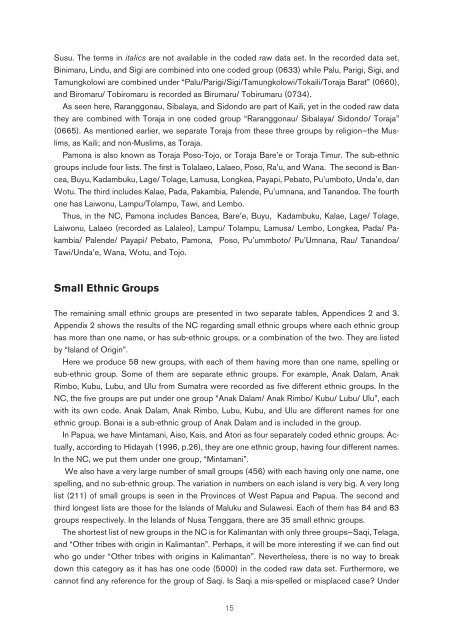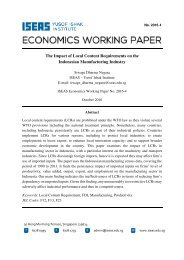1eM4IJR
1eM4IJR
1eM4IJR
Create successful ePaper yourself
Turn your PDF publications into a flip-book with our unique Google optimized e-Paper software.
Susu. The terms in italics are not available in the coded raw data set. In the recorded data set,<br />
Binimaru, Lindu, and Sigi are combined into one coded group (0633) while Palu, Parigi, Sigi, and<br />
Tamungkolowi are combined under “Palu/Parigi/Sigi/Tamungkolowi/Tokaili/Toraja Barat” (0660),<br />
and Biromaru/ Tobiromaru is recorded as Birumaru/ Tobirumaru (0734).<br />
As seen here, Raranggonau, Sibalaya, and Sidondo are part of Kaili, yet in the coded raw data<br />
they are combined with Toraja in one coded group “Raranggonau/ Sibalaya/ Sidondo/ Toraja”<br />
(0665). As mentioned earlier, we separate Toraja from these three groups by religion—the Muslims,<br />
as Kaili; and non-Muslims, as Toraja.<br />
Pamona is also known as Toraja Poso-Tojo, or Toraja Bare’e or Toraja Timur. The sub-ethnic<br />
groups include four lists. The first is Tolalaeo, Lalaeo, Poso, Ra’u, and Wana. The second is Bancea,<br />
Buyu, Kadambuku, Lage/ Tolage, Lamusa, Longkea, Payapi, Pebato, Pu’umboto, Unda’e, dan<br />
Wotu. The third includes Kalae, Pada, Pakambia, Palende, Pu’umnana, and Tanandoa. The fourth<br />
one has Laiwonu, Lampu/Tolampu, Tawi, and Lembo.<br />
Thus, in the NC, Pamona includes Bancea, Bare’e, Buyu, Kadambuku, Kalae, Lage/ Tolage,<br />
Laiwonu, Lalaeo (recorded as Lalaleo), Lampu/ Tolampu, Lamusa/ Lembo, Longkea, Pada/ Pakambia/<br />
Palende/ Payapi/ Pebato, Pamona, Poso, Pu’ummboto/ Pu’Umnana, Rau/ Tanandoa/<br />
Tawi/Unda’e, Wana, Wotu, and Tojo.<br />
Small Ethnic Groups<br />
The remaining small ethnic groups are presented in two separate tables, Appendices 2 and 3.<br />
Appendix 2 shows the results of the NC regarding small ethnic groups where each ethnic group<br />
has more than one name, or has sub-ethnic groups, or a combination of the two. They are listed<br />
by “Island of Origin”.<br />
Here we produce 58 new groups, with each of them having more than one name, spelling or<br />
sub-ethnic group. Some of them are separate ethnic groups. For example, Anak Dalam, Anak<br />
Rimbo, Kubu, Lubu, and Ulu from Sumatra were recorded as five different ethnic groups. In the<br />
NC, the five groups are put under one group “Anak Dalam/ Anak Rimbo/ Kubu/ Lubu/ Ulu”, each<br />
with its own code. Anak Dalam, Anak Rimbo, Lubu, Kubu, and Ulu are different names for one<br />
ethnic group. Bonai is a sub-ethnic group of Anak Dalam and is included in the group.<br />
In Papua, we have Mintamani, Aiso, Kais, and Atori as four separately coded ethnic groups. Actually,<br />
according to Hidayah (1996, p.26), they are one ethnic group, having four different names.<br />
In the NC, we put them under one group, “Mintamani”.<br />
We also have a very large number of small groups (456) with each having only one name, one<br />
spelling, and no sub-ethnic group. The variation in numbers on each island is very big. A very long<br />
list (211) of small groups is seen in the Provinces of West Papua and Papua. The second and<br />
third longest lists are those for the Islands of Maluku and Sulawesi. Each of them has 84 and 83<br />
groups respectively. In the Islands of Nusa Tenggara, there are 35 small ethnic groups.<br />
The shortest list of new groups in the NC is for Kalimantan with only three groups—Saqi, Telaga,<br />
and “Other tribes with origin in Kalimantan”. Perhaps, it will be more interesting if we can find out<br />
who go under “Other tribes with origins in Kalimantan”. Nevertheless, there is no way to break<br />
down this category as it has has one code (5000) in the coded raw data set. Furthermore, we<br />
cannot find any reference for the group of Saqi. Is Saqi a mis-spelled or misplaced case? Under<br />
15



